Day 1, Friday, March 2nd: Well, here I go again — off to spend a week eating great food in France. There’s less of the unknown this time since I’ve made this type of trip three times before, but there’ll be surprises and disappointments along the way — and lots of great meals, good wines, and pleasant conversation.
It was raining this morning when my plane left San Francisco. But the weather was warmer than where I was going. When we landed in New York, the pilot said the outside temperature was 20 °F — colder than where I left from and even a little colder than where my next flight was heading — Nice. The weather report said tomorrow morning should be about 46 °F and raining. The prediction for later in the week is for warmer weather so I decided to leave the parka at home and adopt my normal, layered demeanor.
©2001, 2014 Peter Hertzmann. All rights reserved.

Day 2, Saturday, March 3rd: After landing an hour late in a foggy, soggy Nice, I met some friends for lunch in Antibes at Taverne Saffranier — home of the best mussels I’ve ever eaten. Then I toddled off to Grasse — my final destination for the week — site of La Bastide Saint-Antoine and Chef Jacques Chibois.
I came to this site to participate in a week of eating, cooking, and touring with eight other Americans at one of France’s two-star restaurants. (In 2001, Michelin awarded 41 of about 50,000 restaurants in France the rating of two stars.) The week was arranged by Les Liaisons Délicieuses, a Washington, DC, based culinary tour company. I had participated with tours from this group before, but this was my first venture to a two-star restaurant.
At 8pm we gathered for aperitifs and our first meal together. This is the time when we all really meet for the first time and the group dynamic starts. So far the group seems compatible, and if I keep my mouth shut, there’s no one trying to dominate the conversation.
The restaurant possesses all the accoutrements involved with the elevated status of having two stars — the level of service, décor, and especially the food. A tray of small hors-d’oeuvres accompanies the apéritif — kir — served us in the lounge at the entrance to the restaurant proper. This would be our routine for the time we spend at the Bastide: gather at eight for aperitifs and hors-d’œuvres before proceeding to the dining room for our meal. As dinner unfolds, we are certainly not disappointed. The menu was
Les premières Asperges en Salade aux Saint Jacques, Pétales de Genêt
(A Salad of the Season’s First Green Asparagus with Scallops, Truffles, and Genista Petals)
Le Saint Pierre en Mimosa, Printanière Provençale
(John Dory and Mimosa Blossoms with Spring Vegetables from Provence)
La Poitrine de Pigeon sur son Nid de Paille de Carotte aux Petits Pois Nouveaux
(Breast of Pigeon on a “Straw Nest” of Carrots and Small Spring Peas)
Le Plateau de Fromages de Méditerranée
(A Tray of Cheeses from the Mediterranean Region)
Le Fourré Chaud de Passion au Chocolat en Senteurs de Fruits de Îles
(Warm, Individual Chocolate Cakes Filled with Passion Fruit with a Fruit Salad and Verbena Ice Cream)
Coffee is accompanied by “Les Douceurs” — a tray of small petit fours. All in all, an excellent way to start the week. We ended after midnight, tired but pleasantly satiated.
©2001, 2014 Peter Hertzmann. All rights reserved.

Day 3, Sunday, March 4th: The morning started off with our first cooking class. This in turn was preempted temporarily by an impromptu tour of the kitchen of the Bastide. When we finally started the class it was immediately apparent that it would be an observation class rather than hands-on. (I have to admit that I prefer this format, but most of the others are disappointed because they want hands-on experience with the recipes. After a discussion between the tour leader and the Chef, he has agreed to have those who want to participate in the preparation to do so.)
The three dishes prepared in class were
Le Mousseux de Champignons au Fois Gras
(Mushroom Soup with Fois Gras)
Le Carré d’Agneau Comme on l’Aime en Provence
à la Poêlée de Légumes aux Herbes Fraîches
(Provençal-Style Rack of Lamb with Pan-Fried Vegetables and Fresh Herbs)
Le Millefeuillles de Pommes Sautées Sauce Caramel
(“Napoleon” of Apples with Caramel Sauce)
Chef Chibois used an induction hob for the demonstration. He spent a considerable time touting the benefits of this method of heating. Even though I had spent a considerable time with the recipes — I had translated them for the class — seeing the preparation answered a lot of questions for me. Following the class we sat down for a lunch that featured these same three dishes. Of course the usual apéritifs, hors d’oeuvres, wines, and sweets accompanied the meal.
In the afternoon, we climbed into the van and went into the center of Grasse for some sightseeing. Laurent, our guide, walked us through the old town, which was pretty much closed down since it was Sunday. We ended the afternoon with a tour of the Musée International de la Parfumerie (The International Perfume Museum). Grasse — which comes from the Latin word for fertile — is the center of the perfume industry in France. Laurent explained how perfume was originally developed in the early 1600s by the town tanners as a means of avoiding taxes on leather production. I had been to the museum before, but it was interesting to see it with a guide.
Dinnertime arrives and I brace myself for another orgy of fine food. Of course, I’m not disappointed.
Rillette de Crustacés au Chou
(Shrimp and Lobster Rillettes with Cabbage)
Le Loup Rôti à l’Huile d’Olive Vanillée
(Roast Sea Bass with Fennel and a Sauce of Onion Juice, Olive Oil, and Vanilla)
Le Lapereau en Senteur de Provence
(Rabbit with Artichokes and Potatoes, Provençal Sauce of Rabbit “Juice” and Herbs)
La Croustille d’Amande et Citron, Sorbet Mandarine
(Almond Cream and Lemon Sorbet-Filled Meringues with Mandarin Sorbet)
And once again, coffee and various infusions were accompanied by “Les Mignardises” — a tray of small petit fours. An added bonus was the fact that we were ending our dinner before midnight.
©2001, 2014 Peter Hertzmann. All rights reserved.
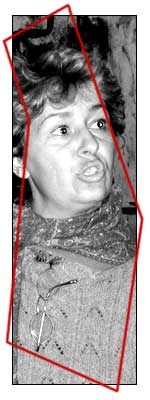
Day 4, Monday, March 5th: At 9am it was time for the second cooking class, and I ambled down to the lobby to meet all my fellow travelers. The Chef was late, but eventually we began. Things were much more organized today, but the Chef was suffering from a cold and it seemed to affect his “performance” slightly
The three dishes to be prepared in class were
La Fricassée Instantanée de Pommes de Terre Rattes du Touquet
aux Calmars, Senteur Grassoise
(“Grasse-Scented” Fricasseed Potatoes and Squid)
Le Denti au Citron et à la Verveine
(Denté with Lemon and Verbena)
La Soupière de Fraises aux Epicés aux Olives Confites
(Spiced Strawberry Soup with Candied Olives)
As happened the day before, the lunch that followed the class consisted of the same dishes prepared in the class, but prepared by the Bastide’s kitchen.
After lunch we visited an olive oil pressing operation — Moulins de la Brague — in the nearby village of Opio. The mill has been in the same family for six generations. They use two types of presses to produce cold-pressed, extra-virgin olive oil. In both cases, the olives are washed and crushed into a paste with giant millstones. In the traditional method, the paste is put between nylon rope mats and then pressed at 400 kg/sq cm to extract the oil. In the new method, the paste is passed through one centrifuge to separate the solids from the water and oil. The liquids are then passed through a second centrifuge that separates the oil from the water. The centrifuges are temperature-controlled so the materials remain below 20 °C. Chef Chibois prefers the oil from the second method because it is more consistent in nature and quality. The mill sells two “flavors” of olive oil: sweet and fruity. The oil produced earlier in the season tends to be fruity and later production is sweeter.
After a brief rest, it was time for another dinner — not required at this point, since none of us were hungry, but certainly enjoyed.
La Tarte Fine Tiède de Morue Fraîche à la Vinaigrette d’Herbes Fines au Citron
(A Fresh Salt Cod Tart with Herb and Lemon Vinaigrette, Beets, and Mixed Greens)
Le Parmentier de Moules et Crevette Truffé
(Potato Pie with Mussels and Shrimp in a Seafood Sauce)
La Caille Servi sur son Chou Vert au Jus de Vin Rouge
(Roast Quail with Red and Green Cabbage and a Red Wine Sauce)
Le Plateau de Fromages de la Bastide Saint Antoine
(A Tray of Cheeses from the Bastide)
Les Croustilles au Éclats de Féves de Cacao, Sorbet Chocolat
au Jus de Fruits de Îles
(Crusty Cocoa Wafers with Chocolate Sorbet with Tropical Fruit Sauce)
©2001, 2014 Peter Hertzmann. All rights reserved.
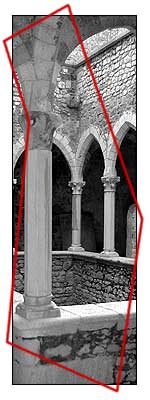
Day 5, Tuesday, March 6th: Some days one just has to be patient. We got a late start on our excursion for the day. We headed down to Cannes where we were to board a boat for a monastery in the middle of the bay. The problem with moving nine people around in a van in France is that city parking can be a problem. Eventually, a two-hour parking space was located on the opposite side of the old port and we boarded our ferry for Île Saint Honorat and the Abbaye de Lérins. We were going to observe their wine production — something they rarely allow outsiders to see. A bald monk with a black and white hassock and a beatific grin greeted us at the dock. After we walked from the dock to the monastery — a half-mile walk to the other side of the island — we were introduced to a different monk, the winemaker. He, along with Chef Chibois, has been responsible for transforming the monastery’s wines into a respected product. He also turned out to be somewhat of a historian. He gave us a tour of the old, ruined military monastery on the adjacent grounds. It turned out that there had been monks on the island since the fifth century, although these ruins dated to the Middle Ages.
By the time we returned to the dock, the boat had left and there would be a two-hour wait until the next one. So we cooled our heels for two hours. Some days one just has to be patient.
Our plan was to go to the next island over for lunch. The Chef had prearranged this and there was no getting out of our appointment. Especially since it had now been moved back to a later time to accommodate our missing the first boat. To get to the next island a thousand yards away we had to go back to Cannes and board a different boat. When we got back to Cannes, the boat we needed to take us to Île Sainte Marguerite wasn’t schedule to leave until after 2pm. Our tour leader, Patti Ravenscroft, did some fancy talking and the crew agreed to make a special trip out to the island for us. (She can be very tenacious when needed — a valuable talent for a tour leader.) Some days one just has to be patient.
We reached our restaurant destination — L’Escale — just after 1pm. The meal started with a thin puff pastry appetizer with melted cheese and tomato sauce. This was followed by:
Soupe de Poisson
(Fish Soup)
Côte de Gigot au Herbes du Provence, Ratatouille
(A Lamb Chop Cooked with Provençale Herbs, Ratatouille)
Crème Brûlée
(Crème Brûlée)
A nice little rosé wine completed the lunch. This time the boat company called Patti on her cell phone and no connections were missed.
On the way back to the hotel we stopped at the village of Mougins — a picturesque little tourist spot with lots of art galleries. I would have preferred to return directly to the hotel, but shopping was promised and it was now time to shop. I purchased a couple of cooking magazines at a news stand and followed the others through the shops and galleries. We finally returned to the hotel at about 6:15 with some very happy shoppers. Some days one just has to be patient.
It seemed that our late lunch was barely over and it was now time for dinner, again. Some days one just has to be patient.
Douceur d’Asperges en Coque de Jaune d’Oeuf aux Fleurs d’Amandier
(Asparagus Soup with a Boiled Egg Yolk and Almond Tree Blossoms)
Lotte Rôtie et sa Purée de Pois Chiche
(Roast Monkfish with Chickpea Puree, Diced Zucchini and Olives)
Suprême de Volaille et Lames de Truffe
(Boneless Chicken Breast with Potatoes, Jerusalem Artichokes, and Truffle Sauce)
Le Plateau de Fromages de la Bastide Saint Antoine
(A Tray of Cheeses from the Bastide)
Gâteau de Chocolat et sa Glacé au Lait d’Amandes
(Warm Chocolate Cakes with Almond Milk Ice Cream)
©2001, 2014 Peter Hertzmann. All rights reserved.
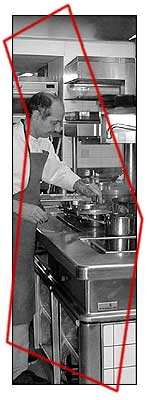
Day 6, Wednesday, March 7th: The group came apart at the seams. Well, not really. We decided to split into two and gather together again at lunch. Half the group went into Antibes to shop and to visit the Musée Picasso. The remainder of us spent the morning in the kitchen with the cooks. For me, this became an opportunity to clean crevettes rose (cooked shrimp) — something I’ve done before — and to shell and clean fresh scallops — something I’ve never done before. While I peeled the crevettes, a cook (my instructor) was at the same station filleting lotte (monkfish). Besides being very ugly, these creatures turned out to be more complicated to fillet than other fish. I think the results are worth the effort!
The scallop shells have a flat side and a convex side. To extract the scallop from its shell, a butter knife was inserted into the shell and scraped along the flat side to release the scallop from that side of the shell. The flat shell was then discarded. The scallop was smoothed out with the flat side of the knife in the half of the shell that it was still attached to. The tip of the knife was then inserted between the fine membrane surrounding the scallop and the meat itself. The scallop was “popped” out of the membrane and set aside. The shell and its remaining contents were discarded. The scallops were then washed of any sand and set aside. And by the way, the scallops are live when the excision starts!
At 11:00 we departed for Nice to meet the rest of the group. We are gathered for lunch in a very small restaurant owned by a relative of a friend of Patti’s. The restaurant, La Merenda, serves local food that is simple but tasty. We ordered à la carte from the chalkboard menu.
After lunch, the group split again. Most of the group headed off to one of the perfume factories in Grasse for a tour and to have individual fragrances designed. Although I was accused of having no scents, I passed and instead, with one other member of the group, headed off to the Musée de l’Art Culinaire in nearby Villeneuve-Loubet. I had visited the museum once before, but I wanted to go again. It is located in Auguste Escoffier’s birthplace and houses many souvenirs of his life as well as historical items from other chefs. My favorite part of the museum was the top floor where some of the museum’s 1500 menus are exhibited. I continually find it very interesting to see what was served in the past. It’s fun to fantasize about eating the food of one of these famous chefs.
But before long, it was time to eat dinner again. Tonight was just as spectacular as the previous nights — maybe more so. The restaurant currently has a special menu available where each of nine courses includes truffles in some form. Tonight’s dinner featured four of these preparations.
La Douceur de Chataigne au Foie Gras en Soufflé de Cèpes Secs
(Chestnut Soup with Fois Gras Cubes and a Dried-Mushroom Soufflé)
Les Saint-Jacques Poêlees avec la Purée de Coco aux Truffes
(Pan-Fried Scallops with White Bean Purée and Truffles)
Le Gigot de Porcelet Rôti aux Herbes, Saltimbanque de Vieux Légumes
(Roasted Baby Pig Leg with Herbs, Winter Vegetables)
Le Croustillant de Fruits de Îles
(Baked Tropical Fruits with a Sabayon Topping)
©2001, 2014 Peter Hertzmann. All rights reserved.
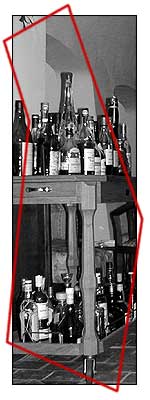
Day 7, Thursday, March 8th: The end is near! Today was the last full day of this splendid week. We started with another cooking class. The curriculum today was
La Palette de Petits Rougets aux Légumes Provençaux
(Small Rougets with a Palette of Provençal Vegetables)
Le Pageot au Jus d’Oignon Nouveau et Petits Artichauts
(Pageot with Onion Juice and Small Artichokes)
Le Moelleux de Chocolat au Coulis de Poires
(Smooth Chocolate Cake with Pear Sauce)
These may be the best recipes of the week. And like before, our lunch had the same selections prepared by the Bastide’s kitchen.
After lunch we headed to one of Provence’s premier wineries — Château Roubine. Located about an hour west of the Bastide, the Château has the oldest vineyard in France. Reputed to have begun in the 14th century, Château Roubine extends over about 260 acres. It once belonged to the Knights Templar, but they sold it in 1307. Since that time there have been many owners. The current owners, Philippe and Valérie Riboud have owned the winery since 1994. I’m not a huge fan of Provençale wines, but the marc was worth a purchase!
Due to the rain and the long drive, we were late getting back to the Bastide. It was past nine o’clock by the time that we started dinner. No aperitifs tonight — we went directly to the main meal.
Papillon de Langoustines en Chifonnade de Basilic
(Dublin Bay Prawns Arranged Like a Butterfly with Green Beans, Salad, and Sliced Basil)
Petités Pistes aux Ravioles à la Nissarte dans Leur Jus
(Baby Squid, Fava Beans, and Raviolis in Their Own Juices)
Flétan Rôti Pommes de Terre Vitelotte aux Truffes
(Roast Halibut with Purple Potatoes and Truffles)
Escalope de Fois Gras Dorée à la Pyramyde d’Artichauts
(Grilled Fois Gras with Artichoke Purée and Green Beans)
Selection de Fromage de Saison
(Seasonal Cheeses)
Calisson Glacé avec Soie Jus d’Huile d’Olive à la Vanille
(A Diamond-Shape Combination of White Chocolate, Melon, Vanilla Ice Cream,
and Gelatin with an Olive Oil Sauce)
This last supper of the week will remain in our memories for a long time!
After dinner, as a way of thank you, the group sang a song, specially written for the occasion by our leader. This was followed by the obligatory group pictures. Bedtime finally came long after midnight.
©2001, 2014 Peter Hertzmann. All rights reserved.
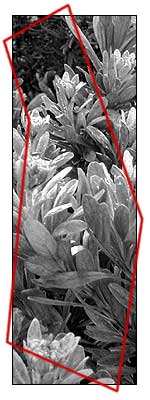
Day 8, Friday, March 9th: All good things come to an end. The ranks of the group dwindled as some members headed towards morning flights home. A few brave members rose early to accompany the Chef to the local market for one of his three-times-a-week shopping trips. The market is one of only two in France that serves professionals exclusively. When they returned, those of us who remained gathered for our last cooking lesson. As in the other classes, three dishes were taught.
Les Asperges aux Olives et aux Féves
(Asparagus with Olives and Fava Beans)
Le Fondant de Canard aux Choux Rouge et Figues Sèches
(Duck with Red Cabbage and Dried Figs)
La Douceur d’Orange aux Petales de Fleurs
(Orange Sorbet with Flower Petals)
After further attrition, the last four group members gathered for our last meal at the Bastide. The kitchen’s version of the three dishes we’ve just seen Chef Chibois demonstrate — a tasty way to end a glorious week.
As I drove away from the Bastide, the last person to leave, I thought back over the many pleasant memories I had of my week in Grasse.
©2001, 2014 Peter Hertzmann. All rights reserved.
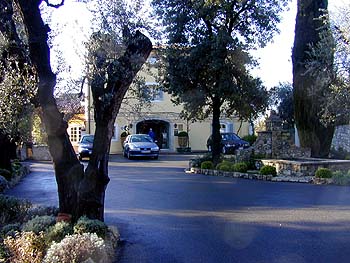
The entrance to the Bastide appears from behind the trees.

A traditional water spigot is outside the Bastide’s front door.
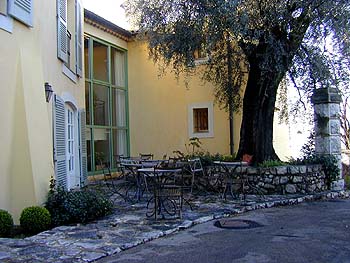
One of the outdoor sitting areas — it must be nicer in the summer!

In the summer, the restaurant service is outside.
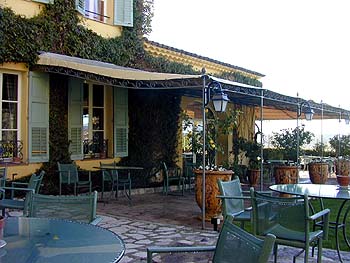
More of the patio...
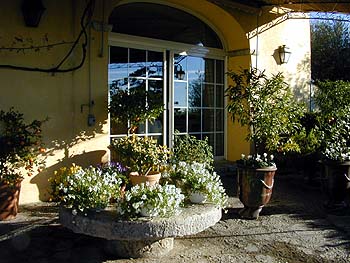
...and the garden entrance to the dining room.
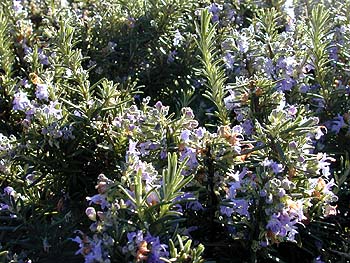
Spring must be just around the corner, because the Bastide’s luscious gardens are beginning to come alive.

Aperitifs are served in the lounge.
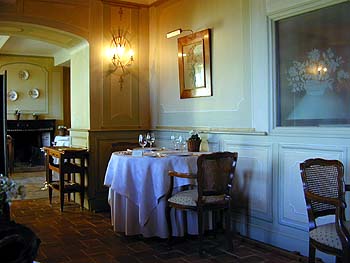
Dine in one of the intimate dining spaces...

...or in the main dining room.
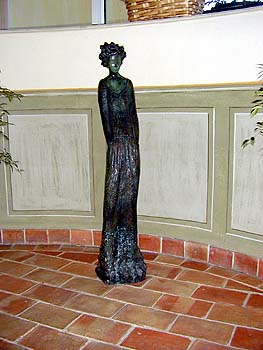
The Bastide is filled with original artwork.

©2001, 2014 Peter Hertzmann. All rights reserved.
Sunday Morning, March 4, 2001
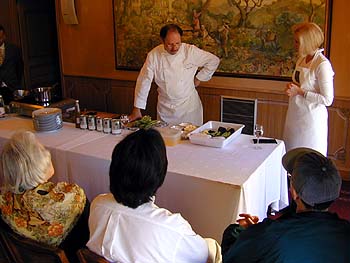
Chef Chibois explains the ingredients for a dish while Wendy Whitehurst translates.

Chef Chibois guides a couple of the students who volunteer to help with the preparation.
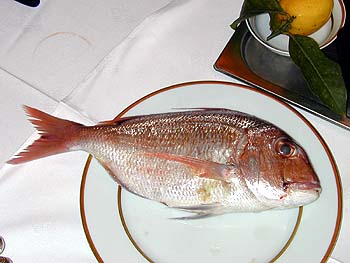
The guest of honor for today’s class.

The Chef demonstrates his technique for peeling asparagus.

Before this duck can be cooked it must be trussed.
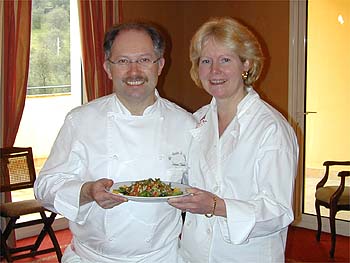
Chef Chibois and tour leader Patti Ravenscoft proudly show off a completed dish.

©2001, 2014 Peter Hertzmann. All rights reserved.
Sunday Afertnoon, March 4, 2001
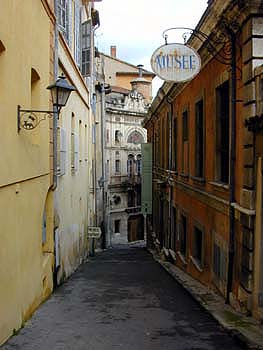
Grasse is an old, walled city built on a hillside overlooking
the Mediterranean Sea.
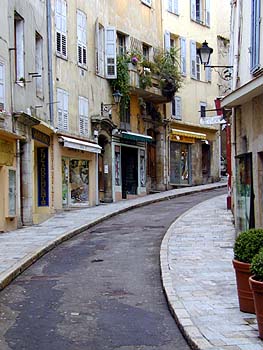
In the old part of town, the streets follow the curves of the hills...
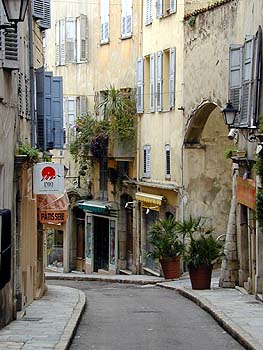
...and are a bit empty on Sunday afternoon.
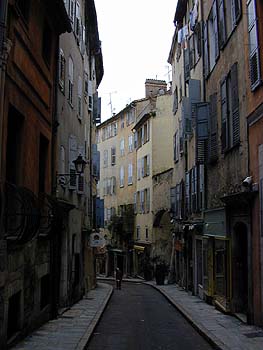
It’s not too cheerful on an overcast day, either.

The town’s war memorial is located near the highest point in Grasse.
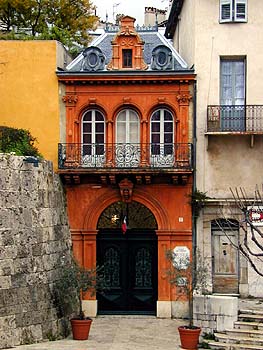
The narrow facade of the perfume museum hides three floors of
exhibits that cover a large portion of a city block.

©2001, 2014 Peter Hertzmann. All rights reserved.
Monday Afternoon, March 5, 2001

The olive oil mill had two types of presses. The traditional method,
shown in this picture and the next, starts by crushing the washed and
stemmed olives with these huge stone wheels.
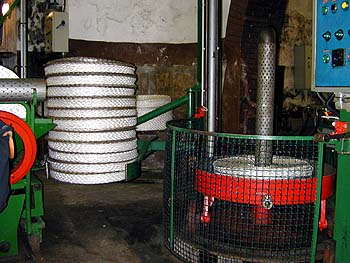
The olive paste is placed between these rope disks and the oil
is expelled in the press.
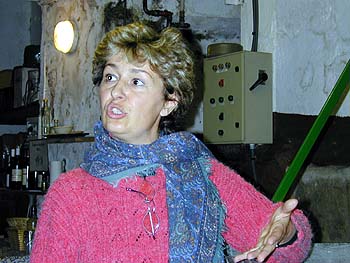
Our guide explains the whole process.
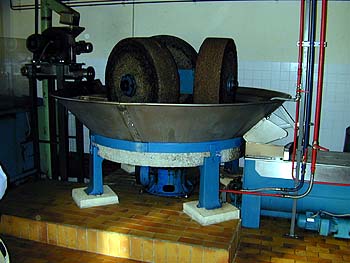
The modern method starts with crushing, too.
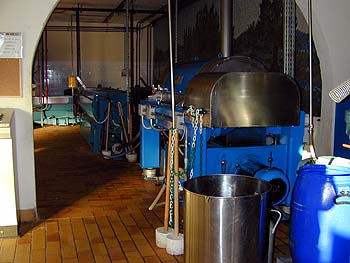
A pneumatic press expells the liquids from the paste.
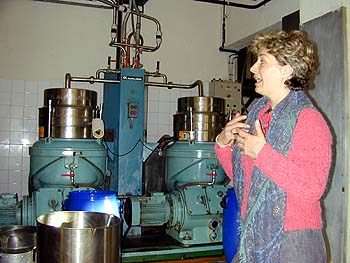
Our guide then explains how the liquid is centrifuged to
separate the water from the oil.

©2001, 2014 Peter Hertzmann. All rights reserved.
Tuesday Morning, March 6, 2001
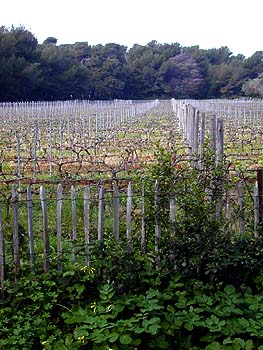
After arriving at the island, we saw one of the monastery’s rehabilitated vineyards. They’ve produced sacramental wines
for centuries on the island, but have only recently
started to produce fine wines.
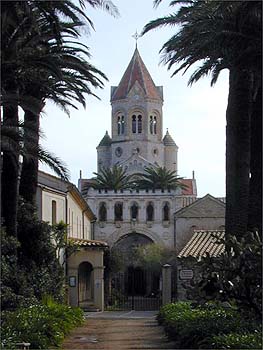
On the opposite side of the island from the dock, we approach the monastery. Unfortunately, we didn't get much closer than this path.
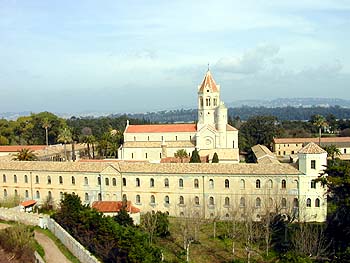
Another view of the monastery from the now abandoned
fortified church nearby.
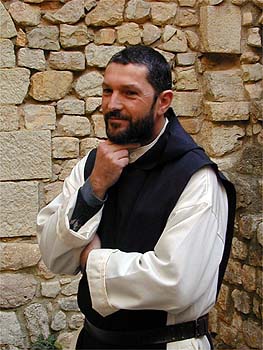
Our guide of the fortified church listens to a question
from the group.
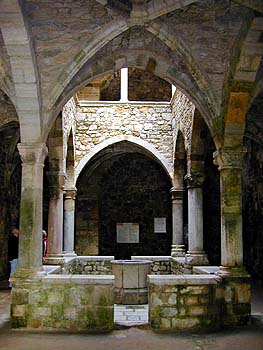
The ground-floor level view of the fortified church’s
central atrium and well.
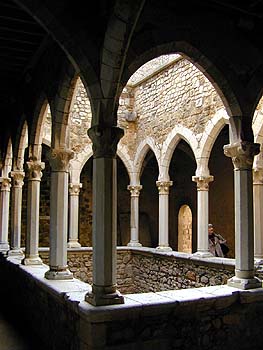
The same atrium from one level up.
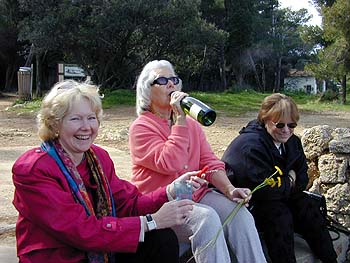
Since we missed the boat back to Cannes, there’s not much
to do except pass the bottle...
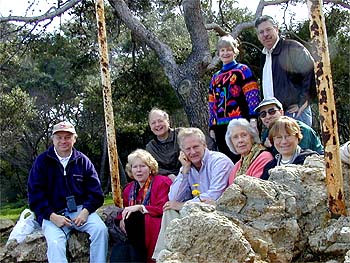
...and take a group picture.

©2001, 2014 Peter Hertzmann. All rights reserved.
Wednesday Morning, March 7, 2001
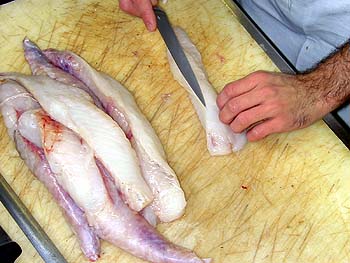
Monkfish are ugly inside and out!
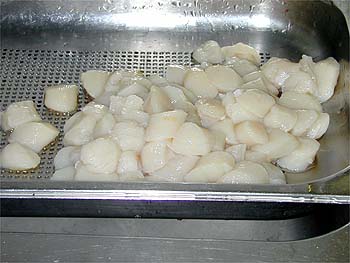
The results of shucking 12 kilos of scallops.
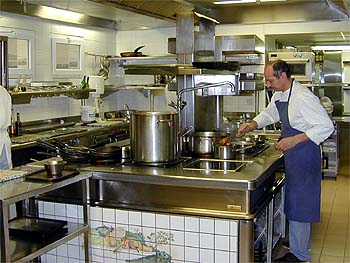
The Bastide’s kitchen is large and spacious compared
to many restaurants. Seen here is the main stove.
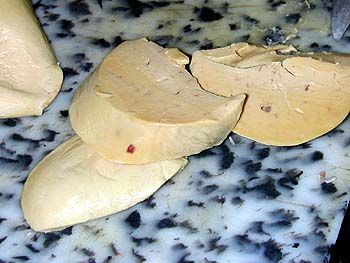
Foie gras cut into medallions for frying.
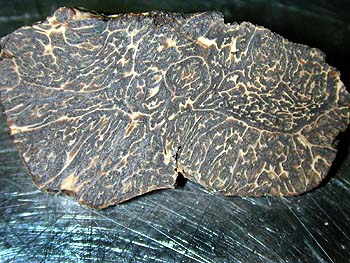
A cross section of the noble truffle. One advantage of coming
to Grasse when the weather is still cold is that truffles
are still available.

©2001, 2014 Peter Hertzmann. All rights reserved.
Lesson 1, Sunday Morning, March 4, 2001
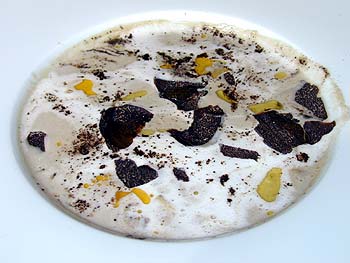
Le mousseux de champignons au fois gras
(Mushroom Soup with Fois Gras)
- 30 g butter
- 50 g peeled, sliced shallots
- 200 g white mushrooms, cleaned and sliced
- 2 tb white wine
- 2 tb Noilly Prat (dry white vermouth)
- 1/2 tb port wine
- 300 g water, or chicken stock
- fine salt and ground black pepper
- 100 g heavy cream
- 1 t bouillon de volaille Maggi (dehydrated chicken stock powder)
- a few drops lemon juice
- 10 g finely minced truffle
- 100 g fois gras, fresh or from a terrine, cut into 1 cm dice
- 10 g finely sliced truffle
- Melt the butter in a saucepan over low heat. Add the shallots and cook, stirring often, for about 5 minutes until golden. Add the mushrooms and continue cooking for 3 to 5 minutes. Stir occasionally to ensure that the mushrooms cook evenly.
- Add the white wine, port, and vermouth and cook for 2 minutes. Add the water, cream, and chicken stock. Season with fine salt and pepper. Bring to a boil and cook for an additional 5 minutes.
- Transfer the contents of the saucepan to the bowl of a blender. Purée at high speed for a couple of minutes until a smooth, frothy soup is obtained.
- Return the soup to a clean saucepan, add the lemon juice, and bring to a boil. Adjust the seasonings. Add the minced truffle. Using a whisk, “re-froth” the soup.
- Divide the fois gras cubes among the serving bowls.
- Gently divide the soup over the fois gras. Carefully garnish the soup with truffle slices, a few drops of cream, and a few drops of a high quality olive oil [optional].
Yield: 3 to 4 servings.

Le carré d’agneau comme on l’aime en Provence
à la poêlée de légumes aux herbes fraîches
(Provençal-Style Rack of Lamb with Pan-Fried Vegetables and Fresh Herbs)
- 1 rack of lamb with 9 ribs, back fat trimmed, meat and fat removed from rib tips, vertebral bones removed and reserved
- for the sauce:
- 15 cl lamb “juice”, made from the vertebral bones of a rack cut very small and pan-fried in 2 tb olive oil with a little onion, 1/4 t garlic, fresh thyme, fresh rosemary, fresh bay leaf, diced tomato core, 1 t dehydrated chicken stock, 2 tb white wine, salt, pepper and water, and cooked for 30 minutes; strained
- 60 g butter
- 1 leaf fresh basil, minced
- leaves from 1 small sprig fresh tarragon, minced
- 150 g firm tomato, peeled, seeded, and 1 cm diced, cores reserved for “juice”
- for the vegetables:
- 2 tb olive oil
- 200 g very small new potatoes, washed and quartered
- 4 small artichoke hearts, cut into 6 wedges
- 4 small, about 90 g each white onions, peeled and quartered
- 4 small cloves garlic, peeled
- 100 g small, young zucchini, cut lengthwise and then into 2 cm long pieces
- 5 cm sprig fresh thyme
- 5 cm sprig fresh rosemary
- 1 small leaf fresh bay leaf
- 5 leaves fresh basil, finely sliced
- leaves from 1 small sprig fresh tarragon, minced
- 40 g butter
- Preheat an oven to 200 to 220 °C. Season the rack of lamb with a little oil, salt, and pepper. Place in a roasting pan and cook for about 15 minutes. Start with the rack placed fat side down. After5 minutes turn it so the vertebral side is down. After 5 more minutes turn it rib side down. Transfer the rack to a plate, cover with aluminum foil, and set aside for 15 minutes to rest.
- For the vegetables: heat the oil in a nonstick frying pan over medium heat. Add the potatoes and brown a bit. Add the artichokes, onions, garlic, thyme, rosemary, and bay leaf. Season with salt and pepper. Cover and cook for about 10 minutes over low heat. Add water as necessary during cooking if the vegetables become too dry. Add the zucchini and cook for about 5 minutes more. Just before serving, remove the herb sprigs, add the basil, tarragon, and butter.
- For the sauce: bring the “juice” to a boil. Reduce slightly and adjust the seasoning. Remove from the heat, incorporate the butter, and finish with the basil, tarragon, and tomatoes.
- Using heated serving plates, divide the vegetables in the center of each plate. Arrange 3 ribs on each plate on top of the vegetables. Spoon the sauce over the meat.
Yield: 3 servings.
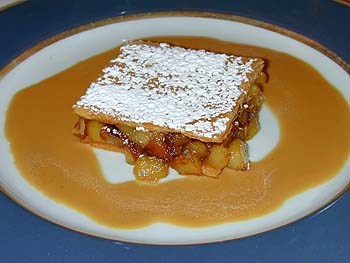
Le millefeuillles de pommes sautées sauce caramel
(“Napoleon” of Apples with Caramel Sauce)
- 100 g puff pastry
- powdered sugar
- 500 g golden delicious apples, peeled, cored, and cut into 1 cm cubes
- 50 g butter
- 30 g sugar
- 1 t vanilla extract
- for caramel sauce:
- 50 g sugar
- 20 g water
- 250 g heavy cream
- 25 g butter
- Roll out the puff pastry until very thin. Let rest in a refrigerator for an hour. Preheat an oven to 200 °C. Put the puff pastry on a baking sheet and place in the oven. When about half cooked, sprinkle the pastry with powdered sugar and continue baking until golden. If the pastry rise too much, place another baking sheet over the pastry to weight it down.
- Cut the cooked puff pastry into 8 pieces, about 8-cm square. Set aside.
- Using a heavy-bottomed or nonstick frying pan, cook the apples in the butter. When about half cooked, add the sugar and mix. When the apples are cooked and browned, mix in the vanilla extract. Set aside in a warm place.
- For the caramel sauce: put the sugar and water in a saucepan and bring to a boil. When the sugar is caramelized, whisk in the cream. (The sauce can be held for up to a couple of days in this form.) Just before serving, reheat the sauce and add the butter.
- For each serving, place a quarter of the cooked apples between 2 squares of pastry. Be sure to line up the sides of the pastry so they are parallel. Sprinkle powdered sugar on the top. Carefully place the apple-pastry stack on top of plate and spoon the sauce around the stack.
Yield: 4 servings.

©2001, 2014 Peter Hertzmann. All rights reserved.
Lesson 2, Monday Morning, March 5, 2001

La fricassée instantanée de pommes de terre rattes du Touquet
aux calmars, senteur grassoise
(“Grasse-Scented,” Fricasseed Potatoes and Squid)
- 400 g fingerling potatoes
- 20 g coarse salt
- 4 tb olive oil
- 16 firm, pitted, black olives, 2 mm dice
- 1 sprig rosemary
- 1 leaf bay leaf
- 4 small sprigs dried fennel sticks
- 1 clove garlic, not peeled, lightly crushed
- 50 g red bell pepper, cored, seeded, cut into 1/2 cm squares
- fine salt and ground white pepper
- 200 g squid hoods and tentacles, cut into 1-1/2 cm squares or pieces
- 100 g tomatoes, peeled, seeded, cut in 1 cm squares
- 10 leaves fresh basil, minced
- a few drops lemon juice
- Add the coarse salt to about 1 liter water and bring to a boil. Add the potatoes and cook for about 15 minutes. Use the tip of a knife to check that the potatoes are cooked. Drain. When cool enough to handle, peel the potatoes, cut into quarters, and slice into 6 mm pieces. Remove any black spots. Set aside on a plate. Cover with plastic wrap.
- Put the oil, rosemary, bay leaf, fennel, garlic, and red pepper in a nonstick frying pan. Season with salt and pepper. Cook over low heat until the peppers are tender. Remove the garlic, fennel, bay leaf, and rosemary. Increase heat to high, salt and pepper the squid, and add to the pan. Cook for barely a minute more. Salt and pepper the reserved potatoes and the tomatoes. Add to the pan and continue cooking to reheat the potatoes. Add the basil and olives. Remove from heat.
- Before serving, sprinkle the mixture with a few drops of lemon juice and mix.
Note: Small scallops may be substituted for the squid.
Yield: 4 servings.
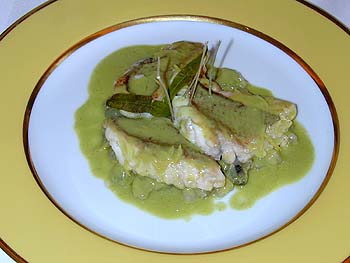
Le denti au citron et à la verveine
(Denté with Lemon and Verbena)
- 4 filets, about 150 g each denté (a type of sea-bream), cleaned and scaled, cut into parallelogram-shaped pieces
- 400 g eggplants, peeled, 1 cm cubes (reserve some of the peel, julliened in 2 cm long pieces and blanched)
- fine salt and ground white pepper
- 1 lemon, for zest and juice
- 7 tb olive oil
- 120 g thinly-sliced white onion
- 3 sprigs dried fennel sticks
- 1/2 clove garlic, crushed and puréed
- 1 t dehydrated chicken stock
- 6 leaves flat parsley
- 10 leaves verbena
- 60 g butter
- olive oil
- 1 clove garlic, peeled and slightly crushed
- Cook the eggplant in 1 liter of boiling, salted (12 g) water for just a minute or two. Drain and cool in ice water. Drain, season with salt and pepper, and set aside with the blanched peel.
- Using a vegetable peeler, peel very thin strips of lemon zest. Cut the pieces into very fine shreds. Set aside.
- For the sauce: put 2 tb olive oil in a saucepan over gentle heat. Add the onions, fennel, 25 cl water, garlic, and chicken stock powder. Season with salt and pepper. Cook over medium heat for about 10 minutes. Part of the way through the cooking, add the parsley.
- When the sauce is cooked, add 5 leaves of verbena. Purée the sauce in a blender until very homogenous. Pass the sauce through a small strainer back into the saucepan. The sauce can be held at this point for up to a day.
- Heat the remaining 5 tb of olive oil in a nonstick frying pan over high heat. Salt and pepper the fish and fry for 2 to 3 minutes on each side. Finish cooking for 4 or 5 minutes in a hot oven. Squeeze a few drops of lemon juice over each fish after cooking.
- To plate: put the eggplant preparation and the garlic clove in a nonstick frying pan and quickly reheat. Adjust the seasoning and finish with 1 tb butter and a few drops of good olive oil. Remove the garlic and put a quarter of the eggplant mixture in the center of each of the serving plates. Arrange the fish, skin side up, on top of the eggplant. Add the zest and a few drops of lemon juice to the sauce and quickly reheat. Whisk in 30 g butter and adjust the seasoning. Spoon the sauce over the fish. Decorate the plates with the remaining verbena leaves and a little dried fennel.
ote: Red snapper or other medium white fish can be substituted for the denté.
Yield: 4 servings.
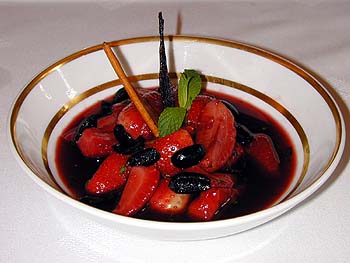
La soupière de fraises aux épicés aux olives confites
(Spiced Strawberry Soup with Candied Olives)
- 600 g strawberries, hulled, halved or quartered, depending on size
- 4 mint leaves, minced
- 4 mint sprig tips
- 4 small cinnamon sticks
- 2 vanilla beans, halved
- for syrup:
- 50 cl red wine
- 50 g finely granulated sugar
- 1 vanilla bean, split lengthwise
- zest from 1/2 orange
- juice from 1 orange
- 2 cinnamon sticks
- 1 small pinch powdered saffron
- for candied olives:
- 80 g large firm black olives, pitted, quartered
- 100 g sugar
- 10 cl water
- For the candied olives: mix sugar, olives, and water in a small saucepan. Bring to a boil. Reduce heat to low and simmer over very low heat for 2 to 3 hours. Do not let them dry out. Drain the olives and spread them on a parchment covered baking sheet to cool.
- Place the syrup ingredients in a saucepan large enough to hold the strawberries as well as the syrup and bring to a boil. Simmer the syrup for about 15 minutes. Add the strawberries and cook for about a minute. Strain the strawberries and chill along with the minced mint. Reserve and chill the syrup separately.
- When the strawberry mixture has cooled, remove and discard the vanilla bean, cinnamon stick, and zest. Combine the strawberries with the chilled syrup and a few drops of lemon juice. Macerate for 2 or 3 hours in a refrigerator.
- Divide the strawberries with their syrup among chilled serving plates. Mound up the strawberries in the center and decorate with a mint sprig, a small cinnamon stick, and half a vanilla bean. Strew the olives over the strawberries.
Yield: 4 servings.

©2001, 2014 Peter Hertzmann. All rights reserved.
Lesson 3, Thusday Morning, March 8, 2001

La palette de petits rougets aux légumes provençaux
(Small Rougets with a Palette of Provençal Vegetables)
- 100 g zucchini, 2 mm dice
- 40 g red bell pepper, cored, 2 mm dice
- 40 g green bell pepper, cored, 2 mm dice
- 50 g fennel bulb, cored, 2 mm dice
- 25 cl olive oil
- 4 cl Noilly Prat (dry white vermouth)
- 1 t minced fresh tarragon
- 100 g tomatoes, peeled, seeded, 3 mm dice
- 1 yellow bell pepper, cored, cut into 1 cm by 5 cm strips, a total of 16 strips required
- 80 g pitted olives
- 12 leaves fresh basil, minced
- 80 g mesclun
- 1 lemon
- 12 small rouget filets, scaled, pin bones removed
- a few sprigs fresh dill
- Separately blanch the zucchini, red and green peppers, and fennel in salted, boiling water. Do not overcook. Drain well. Mix the drained vegetables with 20 cl of olive oil, vermouth, tarragon, and juice from half the lemon. Season with salt and pepper. Finally combine with tomato and set aside.
- Blanch the yellow pepper in salted, boiling water for about 5 minutes. Drain and set aside.
- Chop the olives with half of the basil. Season with salt and black pepper and a little olive oil. Set aside.
- Wash and spin-dry the mesclun. Reserve the rocket (arugula) leaves from the mesclun. Lightly chop the remainder of the mesclun. Set aside.
- Heat a little olive oil in a nonstick frying pan. Salt and pepper the rouget filets and gently fry on both sides. Sprinkle with a little lemon juice.
- Use large round plates for serving. Decorate the perimeter of each plate with 4 pairs yellow pepper strips. Between the strips, divide the olive mixture. Combine the mesclun with the juice of the remaining half lemon, a little olive oil, salt, and pepper. Mound the mesclun in the center of the plates and decorate with a few of the reserved rocket leaves. Lightly chop the remaining 6 basil leaves and scatter around the salad.
- Gently reheat the vegetables. Combine with the remaining basil. Arrange the rouget filets on the salad and divide the warmed vegetables over the filets. Sprinkle the dill sprigs on top.
Yield: 4 servings.
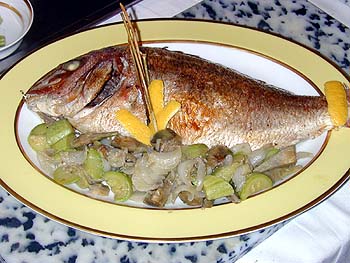
Le pageot au jus d’oignon nouveau et petits artichauts
(Pageot with Onion Juice and Small Artichokes)
- 12 small artichokes
- 1 lemon
- 1, about 1.3 kg pageot, scaled, trimmed, and cleaned
- 6 tb olive oil
- 20 g dried fennel sticks
- 120 g small white onions, cut into wedges
- 20 cl water
- 1 t bouillon de volaille Maggi (dehydrated chicken stock powder)
- 1 t scraped (puréed) garlic
- 20 g coarse salt
- 200 g “round” zucchini (summer squash), cut into 6 wedges each [if regular zucchini are used, cut into 3 cm long by 1-1/2 cm thick strips]
- 30 g butter
- a few drops olive oil
- Using a small knife, peel the artichokes leaving about 3 cm of stem and 1-1/2 cm of the leaves. Cut in quarters and rub with a lemon.
- Preheat an oven to 170-180 °C. Place the fish in a baking pan. Sprinkle with 2 tb olive oil and a few sticks of dried fennel. Bake for about 10 minutes.
- In the meantime, heat 4 tb olive oil over low heat in a small saucepan. Add the onion, artichokes, and the remaining fennel sprigs. Cook for a while without allowing the onions to take on any color. Add the water, chicken stock powder, and garlic. Season with salt and pepper. Simmer until reduced by half.
- While the sauce is being prepared, bring 1 liter of water with the coarse salt to a boil. Add the zucchini and cook for 5 to 6 minutes. The zucchini should stay slightly crunchy. Drain and set aside.
- When the fish is cooked, place it on a serving platter. Remove the fennel from the cooking juices. Drain the liquid from the onion mixture and whisk it into the cooking juices along with the juice from the lemon, the butter, and a few drops of olive oil. Rectify the seasoning and pour the sauce over the fish. Remove the fennel sprigs from the onions and artichokes. Combine the onions and artichokes with the cooked zucchini and arrange around the fish.
Yield: 4 servings.

Le moelleux de chocolat au coulis de poires
(Smooth Chocolate Cake with Pear Sauce)
- for the cakes
- 80 g bitter-sweet chocolate (64% cocoa)
- 20 g bitter chocolate (100% cocoa)
- 100 g butter
- 80 g finely granulated sugar
- 2 extra-large eggs
- 70 g flour
- 1/2 t baking powder
- 1 tb unsweetened cocoa powder
- cocoa powder
- for the sauce:
- 3 poached pears in light syrup, drained, reserving a little syrup
- 20 cl heavy cream
- 1 tb eau de vie poire williams
- Preheat an oven to 180 °C. Prepare 9 cm round by 1-1/4 cm high tart rings with butter and flour. Set aside on a parchment-covered baking sheet.
- Using a double boiler or a heavy-bottomed saucepan, melt the chocolates and the butter together. Remove the chocolate mixture from the heat and whisk in the sugar, followed by the eggs. Combine the flour, baking powder, and cocoa powder and fold into the chocolate mixture with a rubber spatula.
- Transfer the batter to a pastry tube and pipe it into the prepared rings until they are about three-quarters full. Bake until the outside surface is cooked, but the inside is still soft, about 8 minutes.
- Purée the pears in a blender with a little of their poaching liquid. Add the cream and continue to blend. Add the eau de vie. Heat gently until just warm to the touch.
- Spread a little of the sauce in the center of each serving plate. Use a small knife to release the cakes from the rings. Using a large metal spatula to lift the cakes off the baking sheet, place a cake in the center of the sauce. Sprinkle with a little cocoa powder. Serve immediately.
Yield: 4 servings.

©2001, 2014 Peter Hertzmann. All rights reserved.
Lesson 4, Friday Morning, March 9, 2001
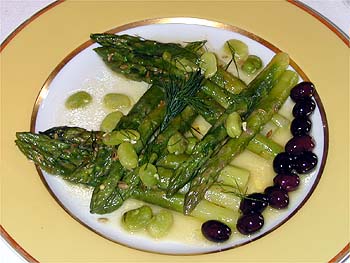
Les asperges aux olives et aux févettes
(Asparagus with Olives and Fava Beans)
- 1 kg small fava beans
- 32 stalks green, medium thick asparagus
- 15 cl water
- 50 g butter
- 1 t anise seeds
- 5 tb Tuscan olive oil
- juice from 1/2 lemon
- 60 g black olives from Nice
- a few drops olive oil
- 4 sprigs dill
- Shell the fava beans. Blanch the beans in salted, boiling water for a minute. Drain and cool in ice water. Drain on absorbent paper. Peel the beans using a finger nail to barely pierce the skin, enabling the meat to slip out. Discard the skins. Set meats aside.
- Peel the asparagus with a vegetable peeler. Wash the stalks and tie into a couple of bundles. Cook in salted, boiling water for 15 minutes.
- In the meantime, put the water, butter, anise seeds, and olive oil in a saucepan. Season with salt and pepper and bring to a boil. Whisk continuously for 1 minute. Add the lemon juice, fava beans, and olives. Rectify the seasonings. Transfer to a serving bowl.
- Drain the asparagus and arrange on the serving plates. Spoon the sauce over the asparagus spears. Drizzle a few drops of olive oil over the top and decorate with a dill sprig.
Yield: 4 servings.
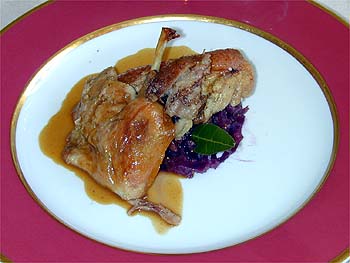
Le fondant de canard aux choux rouge et figues sèches
(Duck with Red Cabbage and Dried Figs)
- for the duck:
- 1, about 800 g duck
- salt and pepper
- 5 cm baguette
- 30 g butter
- olive oil
- 20 g juniper berries
- 1 head garlic, cloves separated but not peeled
- 2-1/2 kg coarse salt for baking
- for the cabbage:
- 200 g red cabbage, cored, thinly sliced
- 30 g butter
- 70 g onions, peeled, coarsely minced
- 2 good-quality dried figs, stems removed, finely diced
- 6 cl water
- 3 tb wine vinegar
- To prepare the duck: preheat an oven to 160 to 180 °C.
- Season the cavity of the duck with salt and pepper. Cut the baguette lengthwise. Butter the cut surfaces. Put the buttered surfaces together and place into the cavity. Truss the duck with string. Tie the tail inward to keep the baking salt out of the duck’s cavity. Rub the duck with a little oil, season with pepper, and delicately wrap in parchment paper along with the juniper berries and the loose garlic.
- Using an oval-shaped stock pot, barely large enough to hold the duck without the duck touching the edges, cover the bottom of the pot with the salt mixture. Place the duck in the center and cover totally with the remaining salt. The duck should not be touching the sides of the pot and should be completely covered with salt. Put the pot in the oven and roast for 1-1/2 hours.
- Melt the butter in a large saucepan over medium heat. Add the onions and cook until golden. Season with salt and pepper. Add the figs and the water. Stir continuously until the figs dissolve and the water evaporates.
- In the meantime, cook the cabbage in salted (20 g/l), boiling water for 5 or 6 minutes until tender. Add the wine vinegar, boil a minute longer, rinse in cold water, and drain. Add the cabbage to the saucepan with the onions and figs. Mix well.
- To serve, remove the duck from the salt and unwrap. Divide the cabbage among the serving plates. Cut the duck into 4 pieces and put 2 on each plate.
Yield: 2 servings.
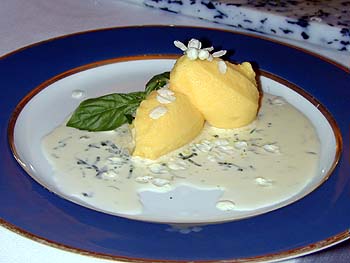
La douceur d’orange aux petales de fleurs
(Orange Sorbet with Flower Petals)
- for the sorbet:
- 75 cl fresh-squeezed orange juice
- 25 cl fresh-squeezed lemon juice
- 100 g sugar
- for the sauce:
- 20 cl heavy cream
- 1 tb sugar
- 1/2 t potato starch dissolved in 1/2 tb water
- 1 tb olive oil
- 3 leaves fresh basil, thinly sliced
- a few drops orange water
- a few drops lemon juice
- for the decoration:
- candied black olives
- 4 sprig tips fresh basil
- olive oil
- 10 g plum blossoms
- To prepare the sorbet: mix the ingredients until the sugar dissolves and place in an ice cream machine to freeze.
- To prepare the sauce: put the cream and sugar in a saucepan and bring to a boil. Whisk in the cornstarch mixture to thicken the cream, and remove from the heat. Whisk in 1 t of olive oil and the basil. Chill in the refrigerator.
- To serve: add the orange water and lemon juice to the sauce and mix. Divide the sauce among the serving plates. Drain the olives and strew over the sauce. Place two quenelles of sorbet in the center of the sauce.
- Decorate the quenelles with a basil sprig and a few drops of olive oil. Finally, strew the flower petals over the plates.
Yield: 4 servings.

©2001, 2014 Peter Hertzmann. All rights reserved.
Dinner, Saturday, March 3, 2001

A typical tray of hors-d’œuvres that preceded each dinner
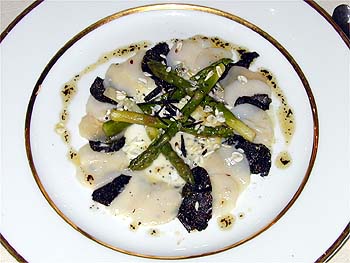
Les premières Asperges en Salade aux Saint Jacques,
Pétales de Genêt
(A Salad of the Season’s First Green Asparagus with Scallops, Truffles, and Genista Petals)
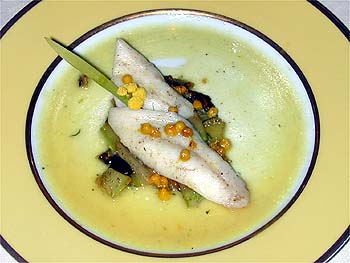
Le Saint Pierre en Mimosa, Printanière Provençale
(John Dory and Mimosa Blossoms with Spring Vegetables from Provence)
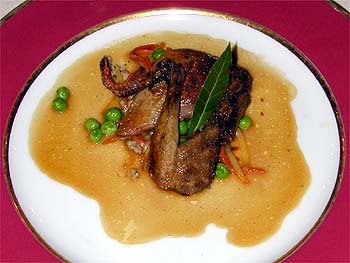
La Poitrine de Pigeon sur son Nid de Paille de Carotte
aux Petits Pois Nouveaux
(Breast of Pigeon on a “Straw Nest” of Carrots and Small Spring Peas)
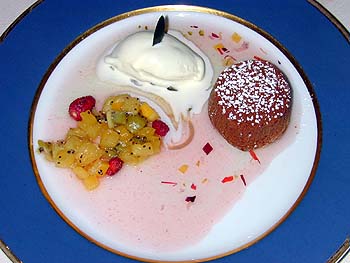
Le Fourré Chaud de Passion au Chocolat
en Senteurs de Fruits de Îles
(Warm, Individual Chocolate Cakes Filled with Passion Fruit
with a Fruit Salad and Verbena Ice Cream)

©2001, 2014 Peter Hertzmann. All rights reserved.
Lunch, Sunday, March 4, 2001
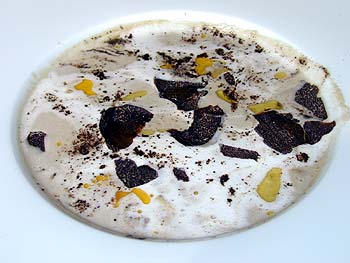
Le Mousseux de Champignons au Fois Gras
(Mushroom Soup with Fois Gras)

Le Carré d’Agneau Comme on l’Aime en Provence à la Poêlée de Légumes aux Herbes Fraîches
(Provençal-Style Rack of Lamb with Pan-Fried Vegetables and Fresh Herbs)
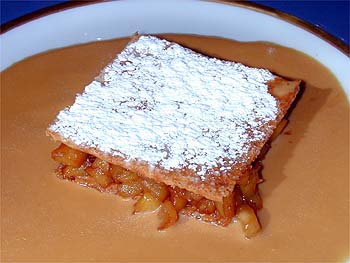
Le Millefeuillles de Pommes Sautées Sauce Caramel
(“Napoleon” of Apples with Caramel Sauce)

©2001, 2014 Peter Hertzmann. All rights reserved.
Dinner, Sunday, March 4, 2001
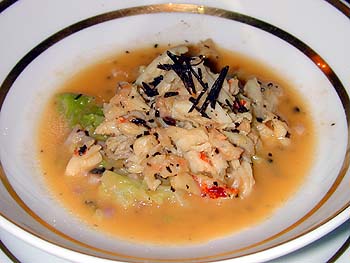
Rillette de Crustacés au Chou
(Shrimp and Lobster Rillettes with Cabbage)
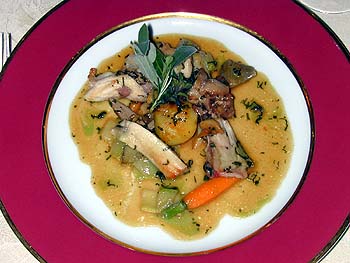
Le Lapereau en Senteur de Provence
(Rabbit with Artichokes and Potatoes, Provençal Sauce of Rabbit “Juice” and Herbs)
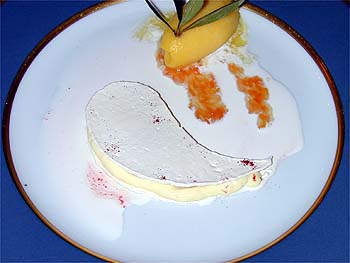
La Croustille d’Amande et Citron, Sorbet Mandarine
(Almond Cream and Lemon Sorbet-Filled Meringues with Mandarin Sorbet)
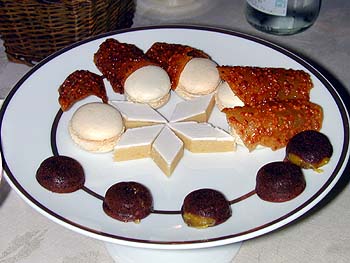
Les Mignardises
(A Tray of Petit Fours)

©2001, 2014 Peter Hertzmann. All rights reserved.
Lunch, Monday, March 5, 2001
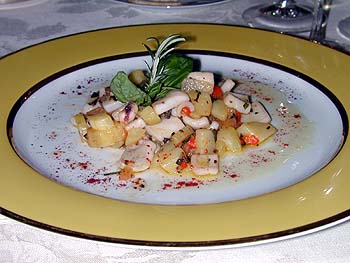
La Fricassée Instantanée de Pommes de Terre Rattes du Touquet
aux Calmars, Senteur Grassoise
(“Grasse-Scented”, Fricasseed Potatoes and Squid)
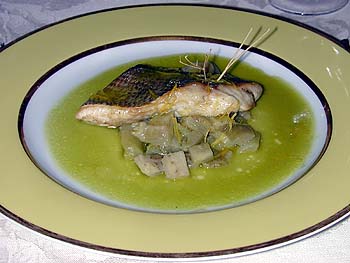
Le Denti au Citron et à la Verveine
(Denté with Lemon and Verbena)
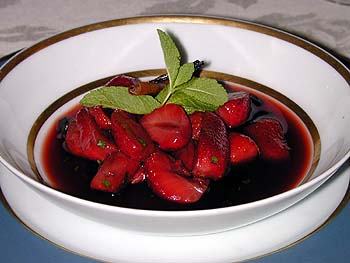
La Soupière de Fraises aux Epicés aux Olives Confites
(Spiced Strawberry Soup with Candied Olives)

©2001, 2014 Peter Hertzmann. All rights reserved.
Dinner, Monday, March 5, 2001
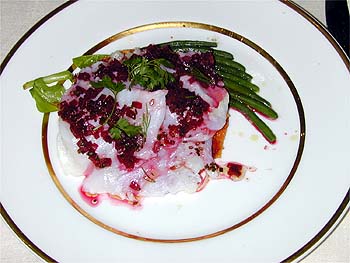
La Tarte Fine Tiède de Morue Fraîche à la Vinaigrette
d’Herbes Fines au Citron
(A Fresh Salt Cod Tart with Herb and Lemon Vinaigrette, Beets, and Mixed Greens)

Le Parmentier de Moules et Crevette Truffé
(Potato Pie with Mussels and Shrimp in a Seafood Sauce)
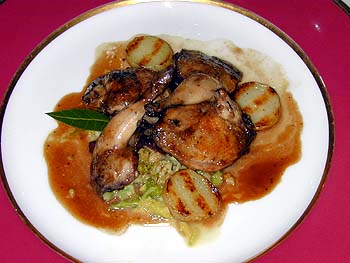
La Caille Servi sur son Chou Vert au Jus de Vin Rouge
(Roast Quail with Red and Green Cabbage and a Red Wine Sauce)
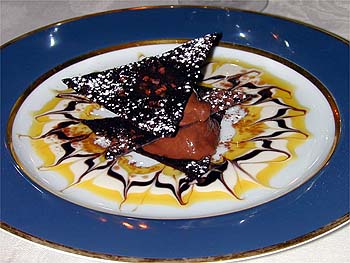
Les Croustilles au Éclats de Féves de Cacao, Sorbet Chocolat
au Jus de Fruits de Îles
(Crusty Cocoa Wafers with Chocolate Sorbet with Tropical Fruit Sauce)

©2001, 2014 Peter Hertzmann. All rights reserved.
Lunch, Tuesday, March 6, 2001
Restaurant l’Escale
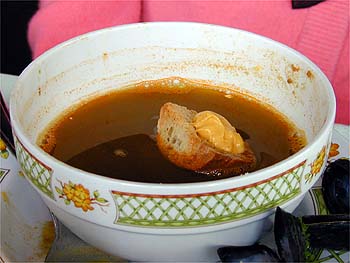
Soupe de Poisson
(Fish Soup)
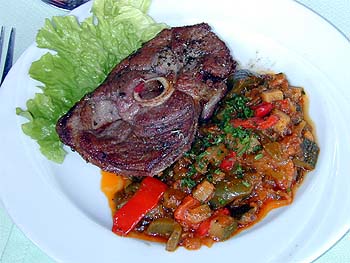
Côte de Gigot au Herbes du Provence, Ratatouille
(A Lamb Chop Cooked with Provençale Herbs, Ratatouille)
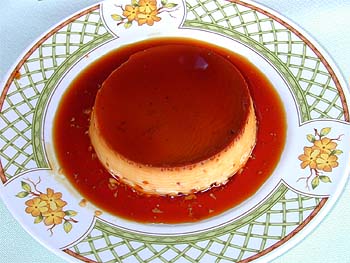
Crème Brûlée
(Crème Brûlée)

©2001, 2014 Peter Hertzmann. All rights reserved.
Dinner, Tuesday, March 6, 2001
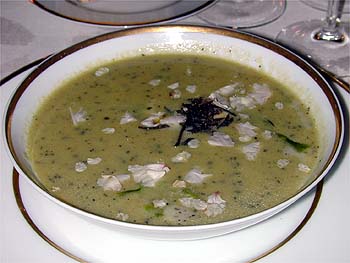
Douceur d’Asperges en Coque de Jaune d’Oeuf aux Fleurs d’Amandier
(Asparagus Soup with a Boiled Egg Yolk and Almond Tree Blossoms)
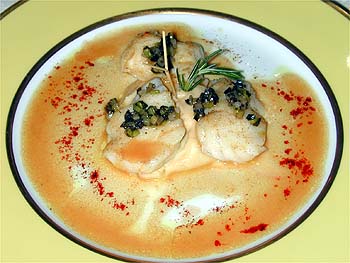
Lotte Rôtie et sa Purée de Pois Chiche
(Roast Monkfish with Chickpea Puree, Diced Zucchini and Olives)
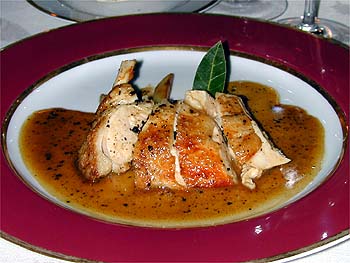
Suprême de Volaille et Lames de Truffe
(Boneless Chicken Breast with Potatoes, Jerusalem Artichokes, and Truffle Sauce)
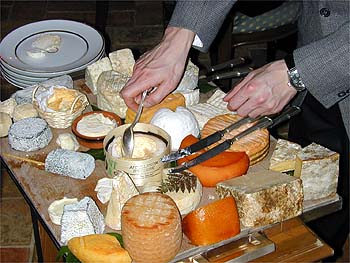
Le Plateau de Fromages de la Bastide Saint Antoine
(A Tray of Cheeses from the Bastide)
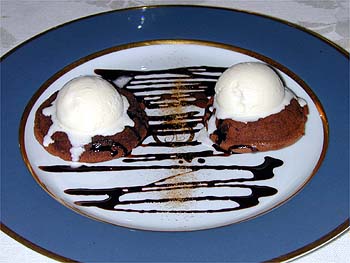
Gâteau de Chocolat et sa Glacé au Lait d’Amandes
(Warm Chocolate Cakes with Almond Milk Ice Cream)

©2001, 2014 Peter Hertzmann. All rights reserved.
Lunch, Wednesday, March 7, 2001
Restaurant La Merenda
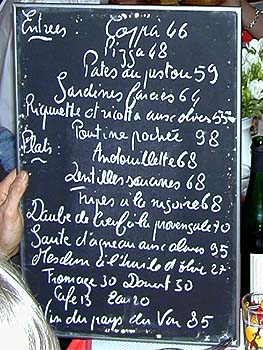
Le carte
(The menu)
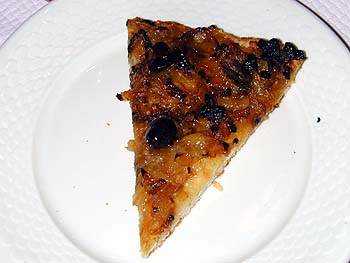
Pizza
(An Onion Tart on a Cornmeal Base)
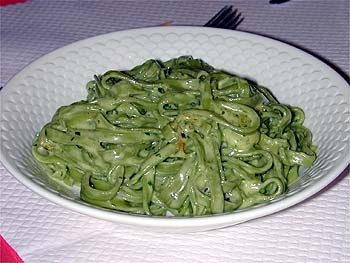
Pâtes au Pistou
(Pasta with a Sauce of Basil, Garlic, and Oil)

Roquette et Ricotta avec Olives
(Arugula and Ricotta with Olives)
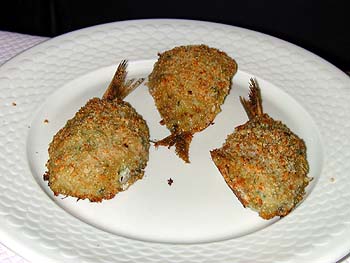
Sardines Farcies
(Deep-fried, Stuffed Sardines)
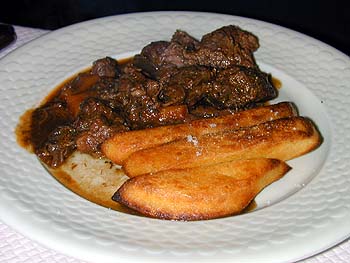
Daube de Bœuf à la Provençale
(Provençal-style Beef Stew)

Lentilles Saucisses
(Lentils with Sausages)

Sauté d’Agneau avec Olives
(Sautéd Lamb with Olives)
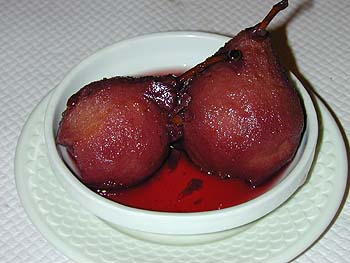
Poires Pochés
(Poached Pears)

Mousse au Chocolat
(Chocolate Mousse)

Tarte Citron
(Lemon Tart)

©2001, 2014 Peter Hertzmann. All rights reserved.
Dinner, Wednesday, March 7, 2001
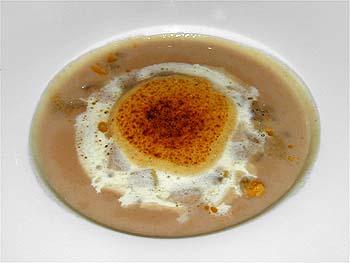
La Douceur de Chataigne au Foie Gras en Soufflé de Cèpes Secs
(Chestnut Soup with Fois Gras Cubes and a Dried-Mushroom Soufflé)
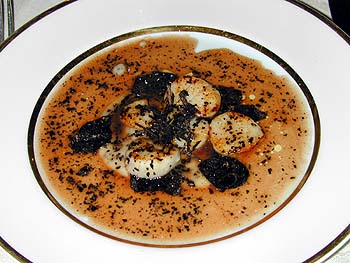
Les Saint-Jacques Poêlees avec la Purée de Coco aux Truffes
(Pan-Fried Scallops with White Bean Purée and Truffles)
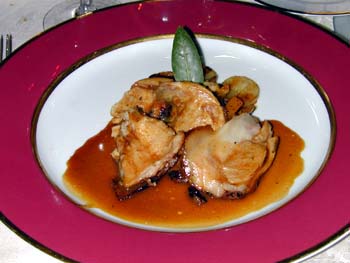
Le Gigot de Porcelet Rôti aux Herbes, Saltimbanque de Vieux Légumes
(Roasted Baby Pig Leg with Herbs, Winter Vegetables)

Le Croustillant de Fruits de Îles
(Baked Tropical Fruits with a Sabayon Topping)

©2001, 2014 Peter Hertzmann. All rights reserved.
Lunch, Thursday, March 8, 2001

La Palette de Petits Rougets aux Légumes Provençaux
(Small Rougets with a Palette of Provençal Vegetables)
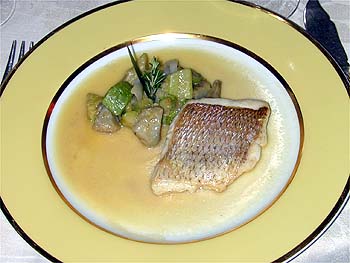
Le Pageot au Jus drsquo;Oignon Nouveau et Petits Artichauts
(Pageot with Onion Juice and Small Artichokes)
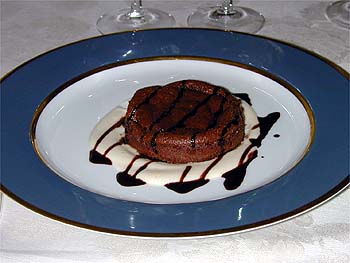
Le Moelleux de Chocolat au Coulis de Poires
(Smooth Chocolate Cake with Pear Sauce)

©2001, 2014 Peter Hertzmann. All rights reserved.
Dinner, Thursday, March 8, 2001
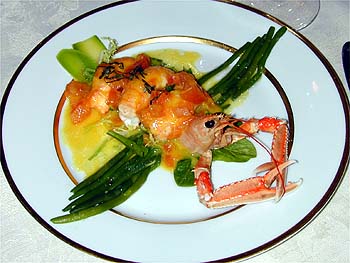
Papillon de Langoustines en Chifonnade de Basilic
(Dublin Bay Prawns Arranged Like a Butterfly with Green Beans, Salad, and Sliced Basil)
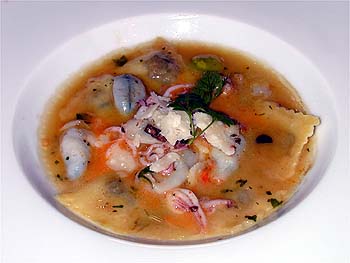
Petités Pistes aux Ravioles à la Nissarte dans Leur Jus
(Baby Squid, Fava Beans, and Raviolis in Their Own Juices)
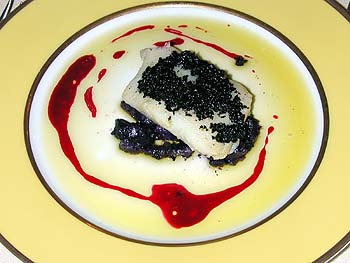
Flétan Rôti Pommes de Terre Vitelotte aux Truffes
(Roast Halibut with Purple Potatoes and Truffles)
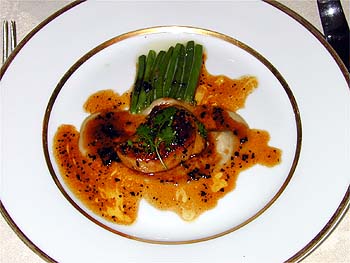
Escalope de Fois Gras Dorée à la Pyramyde d’Artichauts
(Grilled Fois Gras with Artichoke Purée and Green Beans)

Calisson Glacé avec Soie Jus d’Huile d’Olive à la Vanille
(A Diamond-Shape Combination of White Chocolate, Melon, Vanilla Ice Cream,
and Gelatin with an Olive Oil Sauce)

©2001, 2014 Peter Hertzmann. All rights reserved.
Lunch, Friday, March 9, 2001
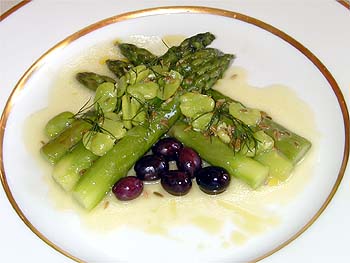
Les Asperges aux Olives et aux Féves
(Asparagus with Olives and Fava Beans)
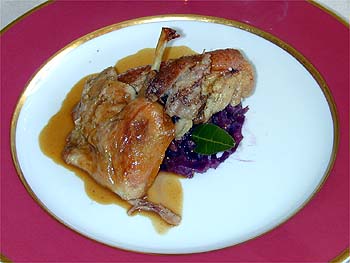
Le Fondant de Canard aux Choux Rouge et Figues Sèches
(Duck with Red Cabbage and Dried Figs)

La Douceur d’Orange aux Petales de Fleurs
(Orange Sorbet with Flower Petals)

©2001, 2014 Peter Hertzmann. All rights reserved.





































































































































